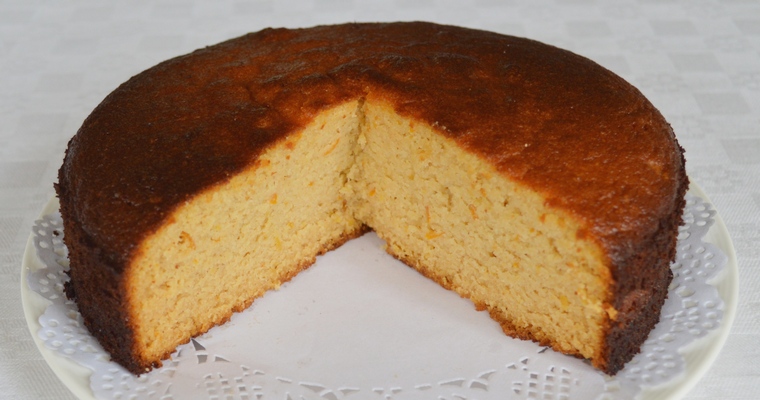Simple cake that is deliciously moist and has a marzipan-like flavour. This Dairy-free, Gluten-free and Paleo recipe is made with ground almonds and honey.
Santiago cake is a flourless almond cake that originates from the Galicia region of Spain. It is a rustic cake that is simple to make and inexpensive, as it contains so few ingredients. What you get in return for your minimal investment is a light, moist cake, tipping almost into pudding territory, that is richly redolent of marzipan.
Happily, Santiago cake is ideally suited to the Paleo diet, in that the recipe is already free from dairy and flour – all you need to do is substitute honey for sugar. So I followed the tips I gave in a previous post on how to replace sugar with honey:
- because honey is denser than sugar, I reduced the amount by 40%
- because honey attracts water less liquid is needed, I reduced the number of eggs by 1
- because honey browns faster than sugar, I reduced the oven temperature from 180°C/350°F to 160°C/320°F, put a layer of tin foil on top of the cake for the first 30 minutes, and increased the cooking time from 40 minutes to 60 minutes to compensate for the lower temperature
As with all flourless cakes, do allow the cake to cool for at least 10 minutes before turning it out of the tin and onto a wire cooling rack. Otherwise there’s a danger your lovely cake will fall apart at the critical moment, in the absence of stretchy gluten molecules holding everything together.
Ingredients
- 2 3/4 cups (250g) ground almonds
- 1/2 teaspoon ground cinnamon
- 5 large eggs, separated
- 3/4 cup (200g) honey
- grated zest of 1 organic lemon
- grated zest of 1 organic orange
- 1/2 teaspoon almond extract
- 1/4 cup (60ml) orange juice (about 1 small orange)
for greasing the cake tin:
- olive oil
Instructions
- Preheat the oven to 160°C/320°F. Lightly grease the sides of a 20cm/8″ round, deep and loose-bottomed cake tin with olive oil, and line the bottom with baking paper.
- In a small bowl, measure out the dry ingredients (ground almonds and cinnamon).
- In a large mixing bowl, measure out the wet ingredients (egg yolks, honey, lemon zest, orange zest, almond extract and orange juice).
- Put the egg whites in a clean, dry bowl and whisk with an electric whisk for 2 minutes, until soft peaks form.
- Mix the wet ingredients until blended using the same whisk. Add the dry ingredients, and stir until blended using a wooden spoon.
- Lighten the mixture by stirring in one-third of the whisked egg whites. Tip in the rest of the egg whites and gently fold in using a spatula: cut down the centre with the side edge of the spatula; scrape across the bottom of the bowl and up the side, scooping up the mixture as you go so that it is turned over and under; rotate the bowl 90° and repeat until fully blended. Be careful not to overwork the mixture and knock out the air, but make sure the bitter egg white is fully blended.
- Pour the mixture into the prepared tin, and transfer to the preheated oven. Bake for 50 minutes – 1 hour, until golden on top and springy to the touch. Rest a sheet of tin foil on top after 40 minutes, to avoid over-browning.
- Wait until the cake has cooled for 10 minutes before running a palette knife around the sides and turning out onto a wire cooling rack.



The lemon and orange in this cake rock!
The perfect recipe for the perfect birthday cake!
It was absolutely delicious 🙂
Rwth, since discovering it, I’ve played with this recipe about ten times (I love it! Thanks!). Thought you might care for a little variant – neither better nor worse than your original, just variety:
Remove: all the lemon and orange zest, orange juice, cinnamon and almond extract.
Reduce almond flour to 2 cups.
Add: 1/3 cup coconut flour, 1/2 tsp baking soda, 1/2 tsp salt, 1/2 tsp cayenne to dry mix.
Add zest of 4 limes and 1/2 cup lime juice.
The coconut flour sponges up the extra juice, which is delightfully complemented by the cayenne and salt kick.
Thanks again for the wonderful recipe and explanations!
Hi Neil, thanks for sharing your variation. That sounds like an awesome cake – a bit reminiscent of a cornbread recipe in terms of the seasoning that you’ve added. I like the idea of blending sour limes and piquant cayenne into a sweet cake, in order to create an unusual balance of flavours (i.e. not just sweet).
When I’m devising a Paleo cake recipe, I generally start with the recipe for a basic pound cake, and then tweak the ratio of eggs, ground almonds, honey and fat according to the additional ingredients that are being added. For example, my carrot cake recipe only has 80ml of olive oil , reduced from the original starting point of 150ml. (This is because grated carrots release water during cooking, and so less moisture is needed from the fat.) Here is my basic pound cake recipe, as I thought you might be interested (in terms of adapting it):
BASIC POUND CAKE INGREDIENTS:
raising agent: 5 eggs (separated), 1 teaspoon baking soda
structure: 200g (2 1/4 cups) ground almonds
sweetness: 170g (5/8 cup) honey
fat / moisture: 150ml (5/8 cup) olive oil
seasoning: 1/4 teaspoon salt
METHODOLOGY:
1. Combine dry ingredients in a bowl and mix (ground almonds, baking soda and salt)
2. Put egg whites in a second bowl and whisk to soft peaks
3. Combine wet ingredients in a third bowl (large) and whisk until fully blended (egg yolks, honey, and olive oil)
4. Tip dry ingredients into wet and stir until blended
5. Lighten mixture by stirring in one-third of egg whites, and then gently fold in remaining egg whites until fully blended
6. Pour batter into a 20cm/8″ round, deep cake tin (prepared by lightly greasing the sides with olive oil, and lining the bottom with baking paper). Bake in a preheated oven at 160°C/320°F until springy to the touch – about 45 minutes – 1 hour. Tent with tin foil after 40 minutes to avoid over-browning on top.